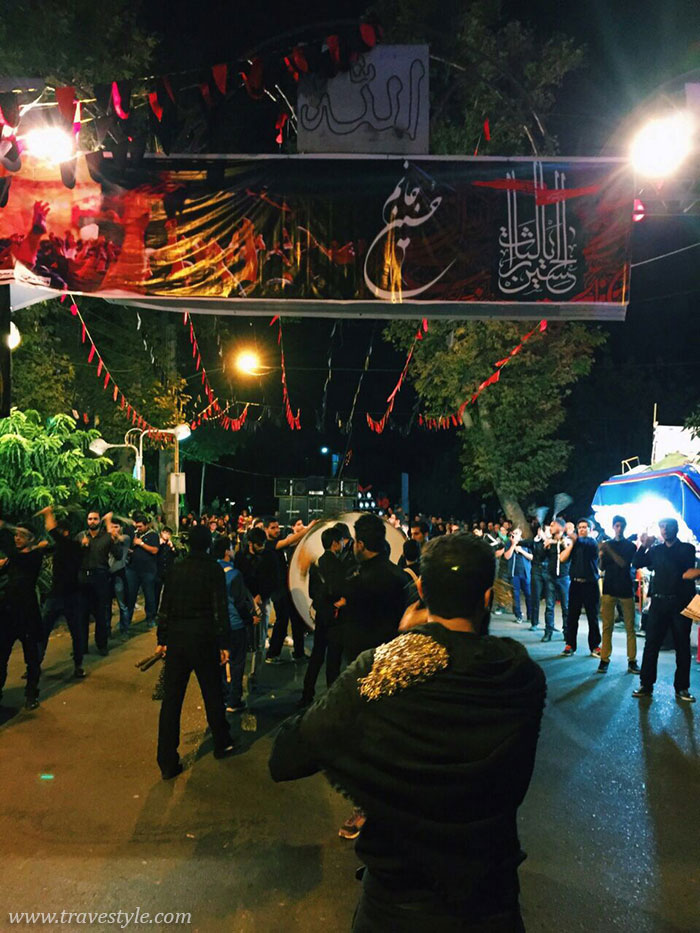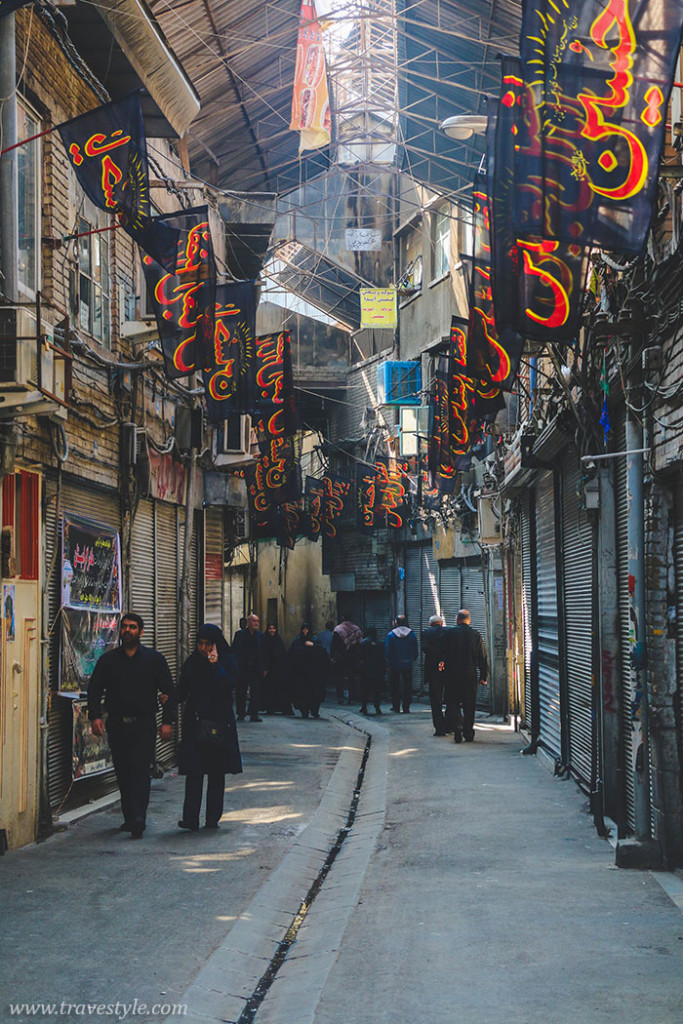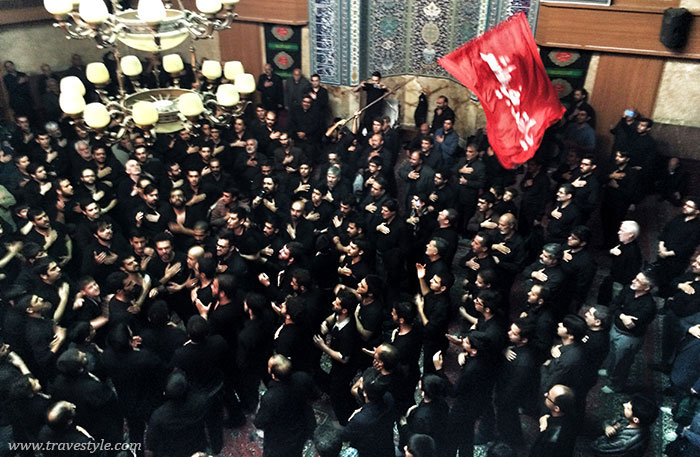I’m sitting in my room writing this post while I hear drums roll and a man on the microphone recites a sorrowful song. Every once in a while my emotions overtake and I’m off to the window to see the scenery I’ve seen thousands of time. A group of men and women dressed in black rally in the street. A huge metal piece decorated with flags with the names of Shia Imams called Alam takes the lead. Young boys follow with their drums and men surround them displaying their devotion to the prophet’s grandson by hitting their backs with a cluster of chains. Women and older men chase by beating their chests with their palms. Similar groups have taken the streets of Tehran these days or better say the whole country. It’s Ashura in Iran!
There’s something unique about Ashura in Iran that never gets ordinary and boosts my curiosity year after year. Years of my childhood are recalled when I would join my parents in the events and watch the same scenery and hear the same music play over and over again.
Today, every beat of the drum hints “home”…
The history of this event is too long and complicated to put into a few words. There are different perspectives and contradictions in the story but just to give an idea of the factors that caused the battle of Karbala and consequently the martyrdom of Imam Hossain and his 72 companions you need to know a few simple things.
So why did it happen?
Following the death of prophet Muhammad there were rivalries in who should succeed the prophet and be the next caliphate. Shias believed the prophet had made it nice and clear that his son-in-law ‘Ali’ was to succeed him and that the Quran and his Ummah (his family) were left to guide Muslims. Sunnis however rejected Ali’s claim and believe that the Quran and Sunnah (teaching of the prophet) were sufficient. Here’s a focal point in the division of Muslims into two sects of Shiite and Sunnism. Imam Ali was assassinated and since his eldest son Imam Hassan (2nd Imam for Shias) did not have enough support he agreed to make peace with his contemporary caliphate. He was also suspiciously martyred. This brings us to the second son of Imam Ali, Hossain who refused to swear allegiance to Yazid (the caliphate) and so the battle of Karbala occurred.
So what’s so tragic about the battle of Karbala?
The battle of Karbala occurred in 680 AD. That’s ages ago! Yet the commemoration is held bigger year after year on the day of Ashura in Iran. There are reasons why this battle is considered so unique amongst Muslims:
#1 The two sides of the battle were extremely uneven. Imam Hossain and his 72 companions in front of an army of thousands.
#2 Women and children were not spared. Many were killed, including 6-month old Ali Asghar the son of Imam Hossain. Others left were humiliated.
#3 Water was banned from Hossain and his clan days before the battle. Many children died from thirst. Many Shia muslims still salute Imam Hossein when they drink a glass of water.
#4 The paradigm of Karbala is pretty much based on resistance of evil, praising freedom and standing up for justice. It has many times become an inspiration to resist oppression in any form.
#5 While the battle had ended by noon, the aftermath was even more devastating. Actions such as bringing the head of Imam Hossain to a feast held by the components and other sorts of humiliation makes the event a lot more dramatic.
#6 Zaynab (Imam Hossain’s sister) and Zayn-ol-Abedin (the succeeding Imam) were among the few survivors. Their subsequent leadership of the resistance, speeches and mourning with the aim to enlighten the people on what had truly happened are some of the strongest facts that Shias hold on to.
#7 There were many other tragic details in the event which are normally the subject of recitations and songs.
#8 The culture of mourning for heroes such as Ashura in Iran goes back to pre-Islamic times when people mourned for the death of Siavash. So this was nothing new to Iranians at the time.
What to expect in the ceremony?
Muharram is the first month of the Islamic calendar (that’s different to the Iranian calender). The mourning starts from the first day and comes to its emotional highpoint on the 10th day called ‘Ashura’ which was the actual day of the battle. Then everything slows down until 40 days after the martyrdom, the day of ‘Arbaeen’ when many embark on a pilgrimage to Karbala, Iraq where the event took place originally. Almost 20 million people gathered there on the day of Arbaeen last year!
Mourning congregations
During these days assemblies called Hossainia which are erected specifically for the mourning of Imam Hossain, mosques and even some private houses hold ceremonies. The ceremony concludes of men and women lamenting and grieving for the death of Imam Hossain. This is sometimes taken to the streets with the beating of drums and men chanting “Ya Hossain” as I explained earlier.
Tazieh
In some streets plays or ‘Tazieh’ is performed re-enacting the battle of Karbala and the suffering of Imam Hossain and his supporters by the hands of Yazid. Yazid and his troops are presented wearing red and the descendants of the prophet in green.
Nazri
Many families cook food or what we call ‘Nazri’ to be distributed among the poor or just anyone (including you!). There are stalls installed on the streets where you get free drinks, normally tea or milk and sometimes food. Almost everyone will eat Nazri during the day of Ashura in Iran instead of cooking their own food. Nazri is believed to be holy and is sometimes given to the sick as a cure. Those who cook or pay for the food to be cooked do this out of devotion to God and Imam Hossain.
A family preparing a stew who were kind enough to invite us inside to get a closer look and be the first to get food.
Sham-e Ghariban (The night of the deserted)
The night of Ashura is known as the night of the deserted. On this night people light candles and gather to immortalize the tragedy of the orphan children abandoned in Karbala after the battle had ended.
Do’s and Don’t
Shedding blood is forbidden in the whole month. This is nothing symbolic. Blood money increases by one-third during Muharram according to the law.
During the month of Muharram people refuse to hold big parties or weddings as a respect to Imam Hossain. Many even refuse to listen to music or avoid entertainment in the first 10 days. Get in a taxi during these days and it’s likely that the music is some sort of recitation of the tragedy of Karbala in a mournful way with a lot exaggeration.
Doing business on the day of Ashura in Iran is considered disrespectful, so expect all shops and attractions to be closed.
What to wear?
The whole country goes black specially on the day of Ashura. If you’re joining an event even if only for the sake of observance it’s respectful to either dress in black or darks. Neutrals are fine but red and brights are almost never seen since they have been symbolizing the evil in anything related to the battle of Karbala.
Where to go?
While Ashura is a sad event, I’ve seen many tourists who were fascinated by it. If you get lucky you might even get to participate in the cooking or distribution of the food. If not there’s always free food. 😉
Each province and city will have their own rituals when it comes to Ashura in Iran. There’s even a ceremony days before Ashura held in Tehran were mothers gather with their infants dressed like Ali Asghar, the 6-month old son of Imam Hossain who was killed on that day.
If you’re in Tehran, the Imam mosque in the grand bazaar holds one of the biggest events but be prepared for a lot of photographers and crowds like you’ve never seen before. Not recommended at all! Other main squares of Tehran like Tajrish sq. are good places to join the event. Yazd is also a very popular destination to see the mourning of Ashura as the locals have their own customs added to the commemoration. But don’t worry, wherever you are in Iran this event is held grandly in every neighbourhood.
Even though the grieving of Ashura in Iran has very much to do with Shia Islam and religious beliefs, today it is rooted so deeply within Iranian culture that it is not unique to religious people or even Shia muslims. Iranian Christians, Jews, Zoroastrians and even Sunnis take part in it many times. Although the younger Iranian generation is a lot less religious and many are not practicing Muslims, you will witness that Ashura has become a part of their national identity.
Read more:
There are tons of books written on the subject which you can find very easily online.
You can check out WHO IS HOSSAIN website which is an organization inspired by the values of Imam Hossain that works internationally.
—————-
My amazing friends were again kind enough to contribute to my post with their photos. Their names are all mentioned under their photos. The rest is mine.
Disclaimer: I’m in no way an expert on the history of Karbala. What I depict is simply from my own observation and readings.


